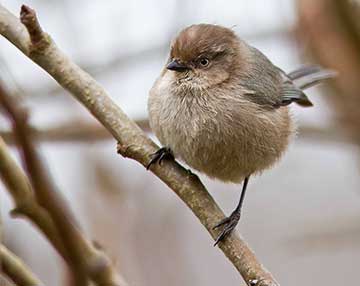 |
Previous Issues |
| Cedar Mill Community Website |
|
Search the Cedar Mill News: |
About The Cedar Mill News |
|
|||||||
| Volume 11, Issue 1 | January 2013 |
||||||
Eating like a Bird
|
 |
| Bushtit, March 2012 ©2013 by Jeff Young |
Outside my window we have a collection of bird feeders. We also deliberately plant foods in the garden known to be attractive to birds, such as crab apple trees and holly bushes loaded with berries. We leave some leaves on the ground for cover for insects. We do not use pesticides, allowing the aphids to flourish on the roses so that the Chickadees can “act like a vacuum” going up and down the stems scooping up protein. I noticed a particular pair of Red Breasted Nuthatches going to the seed feeder and then taking their sunflower seed treat up to a specific branch. They lodged the seed into a crack where they then could hit it repetitively with their beaks to break it open to enjoy. Over and over to the same branch they went.
I also noted the Red Tailed Hawks, which I generally see feeding on rodents and snakes, swoop down and snatch up an unobservant Junco from the ground. I am used to seeing Coopers and Sharp Shinned Hawks eat other birds but had never seen the Red Tailed eat a bird. I think that since the wetlands were so flooded with large amounts of recent rainfall—the typical prey wasn’t available—so this bird switched to what was around to eat.
The most vigorous eater of the day was by far the Varied Thrush. This is a winter bird for us since they breed in Alaska and northern Canada. This bird loves to throw leaves around looking for insects hiding underneath. I often guessed that this bird was about to appear by the amount of leaves being thrown from behind a bush.
The vote for “most adorable” went to the huge flock of Bushtits. These tiny birds with long tails flock up in the winter to feed and perch together. In the spring they pair up to build nests. The flock at our feeder had at least fifty tiny birds eating our suet. Such small beaks but such large bites of suet! I bet they need a lot of food to keep warm. They visited the feeder so many times that by the end of the day the entire suet block was gone. Now other birds did help eat the suet including Yellow Rumped Warblers, Black Capped Chickadees, and Downy Woodpeckers. Northern Flickers, one Ruby Crowned Kinglet, and unfortunately some bully Starlings. But most of the eating was done by the Bushtits.
Scientists have some specific names for types of diets in birds...
Avivorous means to eat other birds, fugivorous means to eat fruit (which few birds eat as their sole diet but many will add), mucivorous (sap eaters like woodpeckers), palynivorous which means pollen eaters and ophiniophagous—snake eaters. Many birds are omnivorous, which means they eat from several categories. In our area, for example, Anna’s hummingbirds prefer nectar (nectivorous) but will switch to eating insects in the winter months (insectivorous) when no flowers are blooming.
Birds eat in amazingly diverse ways—some eat fruit, others eat snakes. Some eat by themselves and others in social flocks. However the phrase “eating like a bird” does not seem to hold up to scrutiny of real bird behavior—most eat a lot and often, and very few are inflexible about what to eat. The major difference appears to be that birds don’t eat for “non food” reasons like humans do. We eat to be comforted, to signal our status, or to have contact in addition to our need for nutrition. So maybe we should “eat like birds” –in some ways at least.
Lauretta Young is a retired chief of mental health at Kaiser who now works at OHSU as the Integrative Medicine Director and teaches medical and MBA students. She also has a small private bird tour business and takes clients birding in Cedar Mill and beyond—see her web site at www.portlandbirdwatching.com. Also see her husband’s photos of Cedar Mill and beyond at www.flickr.com/photos/youngbirders. See another Bushtit photo in the accompanying Pet Barn ad in this edition.
![]()
Like us on Facebook for timely updates
Published monthly by Pioneer Marketing & Design
Publisher/Editor:Virginia Bruce
503-803-1813
PO Box 91061
Portland, Oregon 97291
© 2012